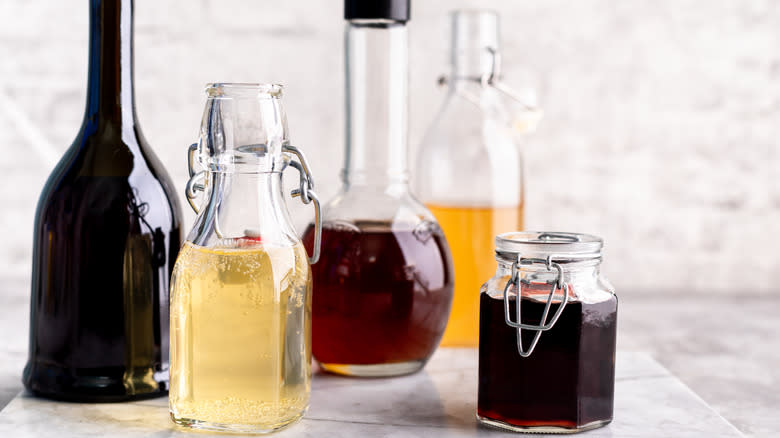Can You Really Make Homemade Vinegar From Leftover Wine?

If you've ever taken a swig of wine left in an open bottle from a dinner or party the night before, you've probably had an unpleasantly sour surprise. The wine has gone bad, but it's on its way to becoming another culinary treasure: vinegar.
With a bit of patience, you really can make vinegar from leftover wine at home, and no wonder, given the French "vinaigre" comes from "vin aigre," meaning sour wine. The easiest way is to leave an open bottle of wine well alone, letting nature, and oxygen, take their course. Just keep it at a warmish temperature — somewhere between 70 and 90 degrees Fahrenheit is ideal — with some cheesecloth or muslin over the top of the bottle to keep any insects out while letting oxygen in, and the wine will begin to ferment.
This is the work of acetobacter aceti, a naturally occurring bacteria that converts alcohol to acetic acid. But as fermentation scientist Dr. Johnny Drain explains in an interview with Liquor.com, "You can allow your wines to oxidize/acidify [become more acidic] spontaneously, but that can be a little haphazard." To take more control of the process, add a small amount of either raw vinegar or unpasteurized vinegar to your wine. This will speed things along, as well as give more repeatable results on your journey into the myriad different types of vinegar you can make at home.
Read more: French Cooking Tricks You Need In Your Life
Exploring The Possibilities Of Homemade Vinegar

Spontaneously letting some old wine ferment is a great way to use up a drink otherwise destined to go down the sink. But making vinegar at home is also an invitation to explore new flavors, rather than being limited by the categories of red or white wine vinegar you typically find at the grocery store. Make a sweet, fruity chardonnay vinegar to dress salad, or a complex, nutty vinegar with the sunset color of orange wine.
There are some things to be mindful of when making vinegar from your favorite wine. Check the alcohol percentage on the bottle — wines over 11% ABV can inhibit the development of vinegar bacteria, so you'd need to dilute them with water to bring down the alcohol level. Sugarier grape varieties, like riesling, will ironically produce a sharper vinegar, and you can expect the richness of a chardonnay or the minerality of an albariño to come through in the vinegar that you make from it.
Once your wine of choice is fermenting, how you like it is up to you. Taste the vinegar after a couple of weeks, and if it's good, strain it off and store it in a clean glass jar or bottle.
How To Have Homemade Vinegar On Tap

If you do dive in and make some homemade vinegar from leftover wine, you'll probably find it has a cloudy substance floating in it. This is the much-prized "mother" — just like the one you might see in apple cider vinegar at the grocery store — and it's your ticket to making vinegar at home over and over again. Don't worry if the mother is lacking or weak to begin with — you can always buy a vinegar starter online, or just substitute raw vinegar until it can fully grow.
When straining off the finished vinegar, reserve some, along with the mother. Then, you can either add a little to your next vinegar to kickstart the fermentation process, or you can go bigger and make "infinite" vinegar. You just need a large vessel with plenty of room for oxygen, and you can start pouring in any leftover wine you might have, waiting for it to ferment before drawing off more vinegar. This won't have the defined characteristics of a vinegar made from a single variety of wine, but rather the complexity and changing flavor of every wine you put into it.
Read the original article on Daily Meal.


